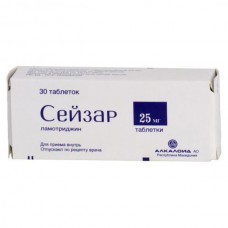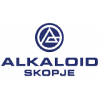Expiration date: 12/2026
Group affiliation: antiepileptics
Description of the active substance (INN): lamotrigine
Dosage Form:
tablets, chewable / soluble tablets, dispersible tablets
Pharmachologic effect:
Antiepileptics. Reduces pathological neuronal activity without inhibition of their function. Stabilizes neuronal membranes by affecting Na + -channels, inhibit excessive release of excitatory amino acids (mainly glutamate) without affecting its normal release.
Indications:
Epilepsy in adults (monotherapy and in combination therapy) and children older than 2 years (only in combination therapy with antiepileptic drugs): partial and generalized seizures (including tonic-clonic and associated with Lennox-Gastaut syndrome). Bipolar disorder (manic-depressive illness).
Contraindications:
Hypersensitivity.
Side effects:
From the nervous system: headache, fatigue, dizziness, drowsiness or insomnia, irritability, aggressiveness, tremor, anxiety, confusion. From the senses: diplopia, blurred vision, conjunctivitis, disequilibrium. From the side of hematopoiesis: leukopenia, thrombocytopenia. From the digestive system: nausea, vomiting. Allergic reactions: skin rash usually maculopapular (usually within the first 8 weeks of treatment, going after drug withdrawal), hypersensitivity syndrome (fever, lymphadenopathy, facial edema, hematologic abnormalities, including anemia, liver dysfunction, rarely - disseminated intravascular coagulation and multiorgan failure ), rarely - malignant exudative erythema (Stevens-Johnson syndrome), toxic epidermal necrolysis (Lyell's syndrome).
Dosage and administration:
Monotherapy: Adults and children over 12 years prescribed in the initial dose of 25 mg 1 time a day for 2 weeks, then increased to 50 mg 1 time a day for 2 weeks. For optimal therapeutic effect, increase the dose of 50-100 mg every 1-2 weeks. The maintenance dose - 100-200 mg / day for 1-2 reception. In some cases, to achieve the required therapeutic effect dose of 500 mg / day. The therapy of valproic acid in combination with other antiepileptic drugs or without them:. Initial dose - 25 mg every other day for 2 weeks, then - 25 mg 1 time a day for 2 weeks. In order to achieve optimal therapeutic effect dose increased by 25-50 mg every 1-2 weeks. The maintenance dose - 100-200 mg / day for 1-2 reception. The therapy with antiepileptic drugs that induce "liver" enzymes (phenytoin, carbamazepine, phenobarbital and primidone), in combination with other antiepileptic drugs or without (except for valproic acid.): Initial dose - 50 mg 1 time per day for 2 weeks, then - 100 mg / day in 2 divided doses for 2 weeks. To achieve optimal therapeutic effect, increase the dose up to 100 mg every 1-2 weeks. The maintenance dose - 200-400 mg / day for 2 admission. Some patients to achieve a therapeutic effect may require a dose of 700 mg / day. Children aged 2 to 12 years: the first two weeks - 2 mg / kg / day in 2 hours, followed by 2 weeks - 5 mg / kg / day, then increased to 3.2 mg / kg every 1-2 weeks prior to onset of effect ( usually 5-15 mg / kg / day in 2 divided doses, maximum 400 mg / day). Children aged 2 to 12 years to achieve the optimal therapeutic effect is carried out a correction mode in accordance with the changes in the child's body weight. If a dose is calculated based on body weight, incomplete match pills should take fewer tablets whole. It is likely that for children aged 2 to 6 years of age will require a maintenance dose, corresponding to the upper boundary of the recommended doses. Soluble / chewable tablets may be chewed, dissolved in a small volume of water (enough to cover the whole tablet) or swallowed whole with water.
Special instructions:
The objective criterion of effectiveness is the ability to decrease the frequency of spikes in the EEG at 78-98%. Individuals with bipolar disorder increases the frequency of suicidal behavior. Weakly inhibits dihydrofolate reductase, and therefore can affect the exchange of folate during prolonged therapy. In abrupt cancellation may increase manifestations of epilepsy, so should abolish gradually over 2 weeks (except in cases that require immediate discontinuation of the drug - the appearance of skin rash). Since the first signs of skin rashes in children can be mistaken for an infection, physicians should consider the possibility of an adverse drug reaction in children who develop a rash and fever during the first 8 weeks of therapy. Increased risk of skin rash, appears to be associated with high initial doses of lamotrigine and a violation of the recommended scheme of increasing doses, with the concomitant use of valproic acid, which increases the T1 / 2 of lamotrigine nearly 2 times. If you have a skin rash should examine the patient immediately and stop taking the drug (except when there is evidence that skin rashes are not related to the drug intake). There are reports that severe epileptic seizures, including status epilepticus may lead to rhabdomyolysis, multiorgan dysfunction, disseminated intravascular coagulation, sometimes with fatal consequences. Such conditions were observed on the background of lamotrigine therapy. In children weighing less than 17 kg impossible to accurately dispense medication in accordance with the above recommendations, using currently produced soluble / chewable tablets 5 mg. There have been reports of the occurrence of dizziness, ataxia, diplopia, blurred vision and nausea in patients taking carbamazepine in combination with lamotrizhdinom (these symptoms usually disappear at lower doses of carbamazepine). During the period of treatment must be careful when driving and other lesson. Potentially hazardous activities that require high concentration and psychomotor speed reactions.
Interaction:
No impact on the concentration in plasma protein binding antiepileptic drugs simultaneously designated, the concentration of levonorgestrel and ethinyl estradiol after administration of oral contraceptives. Compatible with sedatives, antiepileptic drugs and anxiolytics. Antiepileptic drugs (phenytoin, carbamazepine, phenobarbital, pyrimidone), paracetamol accelerate metabolism and shorten the T1 / 2 Lamotrigine 2 times. Valproic acid inhibits liver enzymes lamotrigine metabolism slows down, so that T1 / 2 is extended to 70 hours for adults and up to 45-55 h - in children. Myelotoxicity drugs increase the expression gematotoksichnosti drug.





